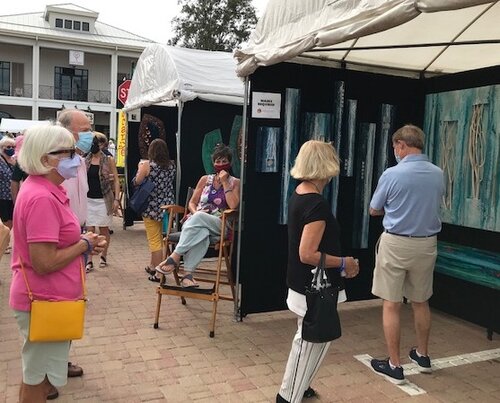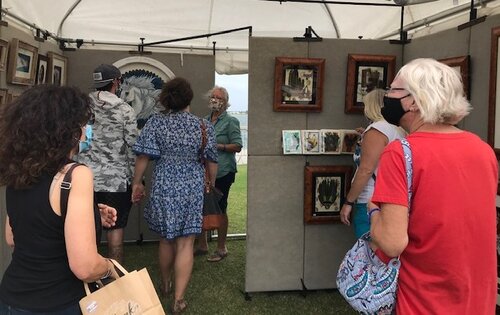by Carolyn Edlund
The 2020 pandemic wreaked havoc on live art events, forcing cancellations and changes to an entire industry. What does this mean for artists going forward? Here’s the inside scoop.

Festival attendees shop for art during the pandemic.
Art fairs and festivals are a mainstay for many artists who earn a living exhibiting at these events. They plan the year carefully to travel to the best venues. But in March, 2020, COVID-19 stopped that cold. Show postponements and cancellations were announced across the board. The pandemic threw festival directors and artists alike into a tailspin, putting some out of business and leaving others scrambling.
This year, I’ve been fortunate to attend industry-level discussions designed to exchange information and come up with solutions. I also served on a team that successfully took the massive 99-year-old Santa Fe Indian Market completely virtual this past summer. And I’ve personally spoken to show producers looking for answers to keep their businesses alive through major shutdowns.
The landscape has changed dramatically for the industry, but ultimately there is a lot of potential. I feel we will come out of this crisis stronger and with more opportunities than ever for artists.
Show Directors Set Priorities
Both nonprofits and for-profits that host events are currently working to diversify and stabilize. They are talking with each other to come up with solutions for event directors, artists, and the public they serve.
It was heartening to learn that a survey found the vast majority of show directors consider the health of individual artists’ small businesses to be a priority, even over their own profits. Individually, show staff took a variety of actions from creating a virtual art fair to simply taking a pass this year. But overall they have a positive outlook and plan to be active in supporting artists while keeping fairgoers safe.
Virtual Shows Emerge
This year, pretty much everything went online, where most commerce was happening. Virtual art fairs and festivals launched in a big way, and they won’t be going away anytime soon.
Solutions varied widely, with efforts ranging from basic efforts to a huge undertaking with all the bells and whistles. Some promoters created an exhibitor directory on their website featuring art images, prices, and artist contact information. Others went big, including live-streamed entertainment, awards ceremonies and live auctions happening behind ticketed paywalls.
Virtual art fairs may be hosted on the fair’s own website, with outgoing links to artist websites where ecommerce is done. Or they may be hosted on third party event websites such as Eventeny and Booth Central, which are rapidly ramping up features and services in a bid to become go-to online event hubs.
Other solutions exist as well. Redwood Media, the promoters of Art Expo, didn’t produce a virtual event, but instead built an entire online gallery to complement their shows. This enables exhibitors to make online sales on a commission basis. Meanwhile, those artists retain their booth space and the right to exhibit when the shows go live again.
Pros and Cons
There are, of course, both positive and negative aspects to virtual fairs. It’s impossible to replace the personal interaction at a live festival, although Zoom conversations with exhibitors and video keep things interactive.
Communication with artists has been a challenge for some show directors. Exhibitors don’t always comply with requests to submit images, set up their virtual booths or hit deadlines. Artists often need training to use event software or hold effective sales conversations with online shoppers. It’s a bit of an uphill climb, but artists should be able to adjust as virtual shows become commonplace.
On the plus side, virtual shows don’t involve travel costs and aren’t affected by bad weather. They can run for much longer than a typical weekend festival, with some shows lasting a month. Show directors can also recruit exhibitors from anywhere, and attract a larger pool of potential applicants.
And promoters may be able to expand their offering from a single, expensive live event to multiple online virtual shows during the year at comparatively little cost. These online shows may even be themed. They could focus on particular topics or mediums, or present art produced by underserved populations. Artists whose work fits a niche could reach a ready audience in a themed show.
Right now, virtual shows are open for business. Interested artists can find listings of upcoming events that are accepting applications. ArtFairCalendar is a free resource with a Virtual Show category for those looking to get involved.
The New Hybrid Model
It’s likely that most art fairs and festivals will have complementary live and virtual components going forward. As in-person events reemerge, many will allow artists to make live and online sales simultaneously. It’s expected that a “hybrid” model will become the norm.
This model offers benefits to artist exhibitors and their customers. Fairgoers who want an in-person experience will visit the show, meet the artists and buy art. A wide audience of buyers who don’t live locally can also view work and make online purchases. Meanwhile, the virtual element can cultivate a cohort of younger shoppers who prefer to shop on the internet. This may be a solution for traditional shows, as their average attendees age and they feel the need to bring in new blood.

Masks, social distancing and other precautions are being used by fair directors.
A Focus on Safety
Live events have begun to happen and further planning is underway. Show directors are looking to put stringent practices into place that prioritize public health and boost the confidence of fairgoers. These include limiting attendance through timed entry, taking temperatures at the show entrance, mask and social distancing requirements, and well-spaced booth displays. Industry-level discussions are ongoing about best practices and workable ideas to hold events successfully while adhering to state and local requirements.
Leaner and Meaner
The pandemic has forced a huge shakeout that has taken down some art fairs and festivals and put many artists out of business or looking elsewhere for income. After a seismic change, survivors often come back stronger than ever. Their ability to weather difficulty is rewarded by a more stable business, less competition and a renewed sense of how to move forward in a changed world.
I’ve spoken with artists who had their best year ever in 2020 despite lockdowns and cancellations. Their businesses thrived because they were ready to adapt and take advantage of openings in the market. Likewise, when live and hybrid shows fully reemerge, there will be ways to leverage those opportunities.
Artist Opportunities
Show directors report that applicant pools have been drastically reduced; sometimes only half of the usual number of artists are applying. With the field dramatically smaller, artists have the chance to apply to shows they aspire to but haven’t previously been juried into. Even in categories like jewelry, photography or painting which are usually crowded, there is reduced competition. Put together outstanding portfolio shots and submit your best possible application to art fairs and festivals at the top of your list. This may be your entrée to get a coveted exhibitor spot.
The calendar has also been rocked, as some fairs reschedule their dates in an effort to avoid the pandemic. This has created conflicts with other shows and opened the door to new exhibitors. As some artists are forced to choose between two concurrent shows where their presence is required, spots become available for others who are new to the venue.
Artists who are not a fan of setting up at a festival and standing on their feet for three days, or if travel makes it impossible, can participate remotely in virtual-only events. One fair director stated that she will be cultivating online-only exhibitors with outstanding work who could never afford to exhibit in past years due to extremely high hotel rates in her city.
Virtual booth fees tend to be low, which gives artists a chance to try a show affordably and determine if they want to exhibit in person in the future.
These opportunities combined with multiple online sales platforms increase the options and allow creative entrepreneurs to develop several income streams. This is a good lesson for artists who depended on the show circuit for their entire income and had to reinvent themselves in the past year.


Thanks for this article, Carolyn. This is something on everyone’s mind and no one has THE answer. There are so many pros and cons here. Doing live shows is a great way to build a mailing list but the travel costs are enormous. There is no substitute for seeing a piece of art in person, then again people are getting quite comfortable shopping online. I started an Instagram page this spring in response to the Corona Virus restrictions and as I scrolled through artists’ pages there, I was astounded to see how many consistent sales and commissions were happening. The online marketing aspect is a big learning curve and for a lot of artists I think it will probably end up being very helpful.
I agree with you Janice and have also heard of many artists getting commissions and selling online this year. The hybrid model that fairs and festivals are developing is also a model for individual artists in business. Keeping that all important in-person contact with online e-commerce as a follow up tool and an ancillary channel that pulls a new audience. I hope you have done well during the pandemic!
Thanks for this article… I have been working on online display, since the Pandemic Lock-Downs and cancellations began. My comment would be that as an artist one must re-invent oneself, and one’s display skills, to think like a programmer with an obsession for details and sequencing. I have found that each platform that I have investigated, including building my own eCommerce website on a Shopify theme, requires that I shoe-horn myself and my work into their format. The result is that an individual artist’s visual presentation is exactly the same as every other artist’s presentation on that type of site! This can be regarded as a help or a hindrance. Our artistic creativity should show up in our entire presentation, not just within a few picture frames. However perhaps it is now easier for a potential purchaser to compare artists’ works. This has changed the way art is evaluated… not for the better!
Valentine, I think you are running up against the limitations of a template ecommerce site, but I believe they are trying to encourage a professional look. You could consider using Word Press, which would be less restrictive in the way you have to present your work.